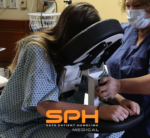In the past, hospital personnel followed safe patient handling guidelines that primarily focused on the safe movement and transfer of patients with staff assistance from surface to surface or from bed to chair for example. Most safe patient handling programs that were implemented really focused on staff injury prevention. And as we all know today the majority of staff injuries come from repositioning patients up in bed and lateral transfers between bed and gurney or bed to table. In the past, keeping a patient in bed just seemed to make sense as patients getting out by themselves or when manually handled by staff were often at risk of falling. Today however, early patient mobility is now a trending practice across the nation. Professional opinions about this topic have changed drastically in recent years as more doctors, nurses and physical therapists have taken an approach that’s evidence based rather than stuck on traditional practices and norms.
Consider the following evidence and ways early patient mobility benefits both patients and staff:
-
Muscle Atrophy or Deconditioning Isn’t Allowed to Set In
Many immobilized patients quickly lose muscle mass, strength and tone. The old saying “If you don’t use it, you lose it” definitely applies to recovering patients. Certain biological processes kick in during immobilization that reduce muscle mass. Movement can help prevent and reverse these processes. Patients who have difficulty with standing and walking can benefit from care out of bed that involves any type of movement. They don’t need to rely on physical help from hospital personnel alone. Several types of assistive tools exist, such as the SPH Medical RoWalker, that can help with this type of safe patient handling program to make it easier for patients to move around and stop muscle wasting as quickly as possible.
-
Prevention of Cardiovascular and Respiratory Events
As the Centers for Disease Control and Prevention notes on its website, immobilized patients are at high risk of experiencing blood clots that can lead to heart and lung problems and strokes. Movement reduces clots by improving circulation. Increased blood flow can improve oxygen levels and respiration. Patients who have suffered a critical illness might also need an oxygen tank to breath when walking. Many assistive tools like the SPH Medical RoWalker have built-in features that make it easier for patients with cardiovascular, respiratory and critical needs to ambulate, such as a telescoping IV pole, a basket that can carry a cardiac monitor or small ventilator, an oxygen tank holder, hand grips and a built-in seat for breaks.
-
Reduction of Hospital and Overall Medical Bills
Hospitals that implement early patient mobility can actually help patients reduce their medical debt burden. It might seem counterintuitive for any type of business to find ways to stop billing customers, but many patients who can’t pay their immediate medical bills are unable to pay them at all as time passes. Growing medical debt then often forces them to put off preventative care, which adversely impacts hospitals when those same patients seek ER care for emergencies they could have prevented in prior weeks, months and years. Additionally, early mobility during an inpatient stay can prevent costly followup ER visits by reducing the risk of related muscular and cardiovascular events. For example, it can reduce the number and length of physical therapy appointments and in-home exercises required for a full recovery, which decreases the patient’s medical debt burden from recovery treatment and the risk of more debt from an emergency atrophy-related muscle strain.
-
Additional Hospital and Staff Benefits
The adoption of early mobility in an ICU and other hospital settings can open up beds faster. If patients are capable of getting up and moving around, they’re not going to need to remain in the ICU for long. Movement can even help staff determine if the patient is strong enough to leave the ICU and breathe without assistance. A safe handling plan that includes assistive and supportive equipment means that staff members won’t have to rush around or experience accidents to retrieve items they need while helping patients. If they’re using a sturdy, durable walking system like the SPH Medical RoWalker, they also won’t need to catch falling patients by hand. They can use the equipment to support the patient’s weight. Lastly, early mobility can help improve patient sleep and mental health, which can reduce ER surges and dangers to staff related to a growing national mental health crisis.



